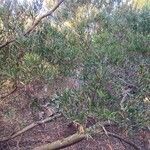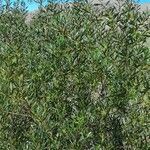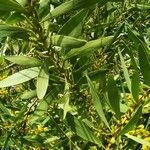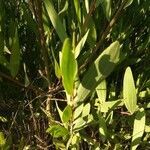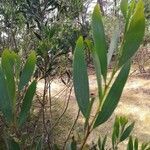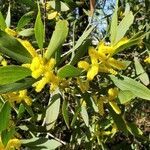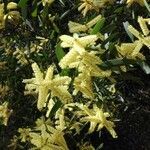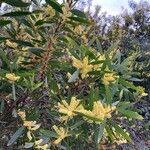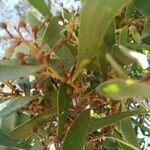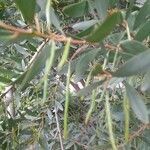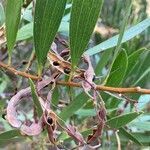Shrub or erect tree, (0.5–) 1–10 m high, 1–25 m wide, spreading. Branchlets glabrous. Stipules deltate, less than 1 mm long or obscure. Phyllodes elliptic to very narrowly elliptic (to ±linear), sometimes obovate to oblanceolate, 4–25 cm long, 10–35 mm wide, acute to rounded-obtuse, sometimes abruptly contracted at apex into mucro, with 2–4 prominent primary veins; secondary veins frequently anastomosing, prominent; margin yellow; gland (1–) 3–8 (–10) mm above pulvinus; pulvinus 2–4 mm long. Inflorescences simple, solitary or twinned; receptacles glabrous; spikes 2–5 cm long; peduncles mostly ±absent; bracteoles caducous, cucullate, 0.3–0.5 mm long, with ciliate margin. Flowers 4-merous; sepals united. Pods cylindrical or subcylindrical, sometimes ±moniliform, 5–15 cm long, 3–6 (–7) mm wide, commonly firmly coriaceous. Seeds elliptic, sometimes irregularly shaped, 4–6 mm long, shiny; funicle folded several times into a thickened lateral skirt-like aril.
Unarmed shrub or tree, up to 10 m high. Branchlets acutely trigonous, older ones angular and ribbed, glabrous. Phyllodes variable as to shape and size, oblong-lanceolate to narrowly linear, straight or slightly curved, 4-16 by 0.3-2.5 cm, acute or obtuse, with 1-5 main veins, secondary veins anastomosing. Spikes loose and interrupted, 1-3 in the distal leaf-axils, 2-5 cm. Flowers yellow, fragrant, tetramerous, bisexual. Pod linear, straight or slightly curved, 2.5-15 by 0.5-0.6 cm, valves coriaceous, convex over the seeds, usually contracted in between. Seeds longitudinal, funicle not folded, thickened almost from the base into a turbinate, almost cup-shaped aril at the base of the seed and sometimes nearly as large.
An evergreen tree. It can be a slender tree or large bushy shrub. It grows to 5 m high and spreads to 3 m wide. The crown is an irregular shape. The stem is straight and erect. The bark is smooth and dull grey. The leaves (phyllodes) are pale green and rigid. They are 15 cm long with veins which run along the leaf. The flowers are golden rods. They occur in large fluffy cylindrical spikes. These can be 5 cm long. The pods are light brown. They are curled and twisted. The pods are constricted between the seeds.
Tree or shrub, 1.5-8.0 m high, stems with spherical galls caused by an introduced wasp. Leaves phyllodia, apparently simple, bright green, glabrous, oblong, 60-180 x 7-20 mm, 2-5 prominent longitudinal veins. Flowers in axillary cylindrical spikes, bright yellow. Pod brown, 70-140 x 4-6 mm, cylindrical, straight or slightly curved, glabrous; margins constricted between seeds, apices acute, dehiscent, valves wrinkled. Flowering time July-Sept.
Small, resprouting tree to 6 m. Phyllodes oblong, with 3-5, longitudinal veins, bright green. Flowers in cylindrical spikes, bright yellow. Pods cylindrical, constricted between seeds.
